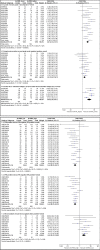Prognostic and predictive values of long non-coding RNA LINC00472 in breast cancer
- PMID: 25865225
- PMCID: PMC4496168
- DOI: 10.18632/oncotarget.3287
Prognostic and predictive values of long non-coding RNA LINC00472 in breast cancer
Abstract
LINC00472 is a novel long intergenic non-coding RNA. We evaluated LINC00472 expression in breast tumor samples using RT-qPCR, performed a meta-analysis of over 20 microarray datasets from the Gene Expression Omnibus (GEO) database, and investigated the effect of LINC00472 expression on cell proliferation and migration in breast cancer cells transfected with a LINC00472-expressing vector. Our qPCR results showed that high LINC00472 expression was associated with less aggressive breast tumors and more favorable disease outcomes. Patients with high expression of LINC00472 had significantly reduced risk of relapse and death compared to those with low expression. Patients with high LINC00472 expression also had better responses to adjuvant chemo- or hormonal therapy than did patients with low expression. Results of meta-analysis on multiple studies from the GEO database were in agreement with the findings of our study. High LINC00472 was also associated with favorable molecular subtypes, Luminal A or normal-like tumors. Cell culture experiments showed that up-regulation of LINC00472 expression could suppress breast cancer cell proliferation and migration. Collectively, our clinical and in vitro studies suggest that LINC00472 is a tumor suppressor in breast cancer. Evaluating this long non-coding RNA in breast tumors may have prognostic and predictive value in the clinical management of breast cancer.
Keywords: LINC00472; breast; lincRNA.
Figures





References
-
- Ferlay JSI, Ervik M, Dikshit R, Eser S, Mathers C, Rebelo M, Parkin DM, Forman D, Bray F. GLOBOCAN 2012 v1.0, Cancer Incidence and Mortality Worldwide: IARC CancerBase No. 11 [Internet] International Agency for Research on Cancer. 2013
-
- Burrell RA, McGranahan N, Bartek J, Swanton C. The causes and consequences of genetic heterogeneity in cancer evolution. Nature. 2013;501:338–345. - PubMed
-
- Roylance R, Endesfelder D, Gorman P, Burrell RA, Sander J, Tomlinson I, Hanby AM, Speirs V, Richardson AL, Birkbak NJ, Eklund AC, Downward J, Kschischo M, Szallasi Z, Swanton C. Relationship of extreme chromosomal instability with long-term survival in a retrospective analysis of primary breast cancer. Cancer epidemiology, biomarkers & prevention: a publication of the American Association for Cancer Research, cosponsored by the American Society of Preventive Oncology. 2011;20:2183–2194. - PMC - PubMed
-
- Stephens PJ, Tarpey PS, Davies H, Van Loo P, Greenman C, Wedge DC, Nik-Zainal S, Martin S, Varela I, Bignell GR, Yates LR, Papaemmanuil E, Beare D, Butler A, Cheverton A, Gamble J, et al. The landscape of cancer genes and mutational processes in breast cancer. Nature. 2012;486:400–404. - PMC - PubMed
Publication types
MeSH terms
Substances
Grants and funding
LinkOut - more resources
Full Text Sources
Other Literature Sources
Medical

